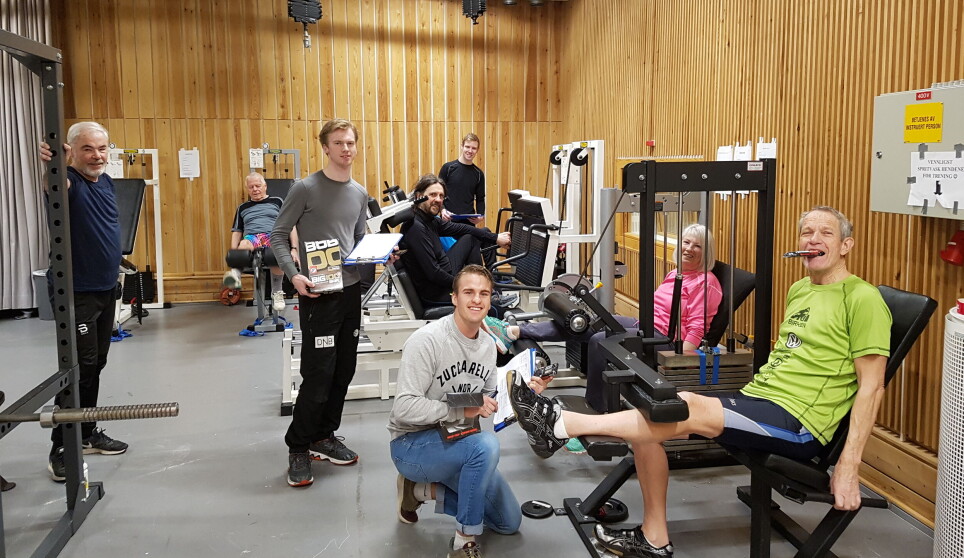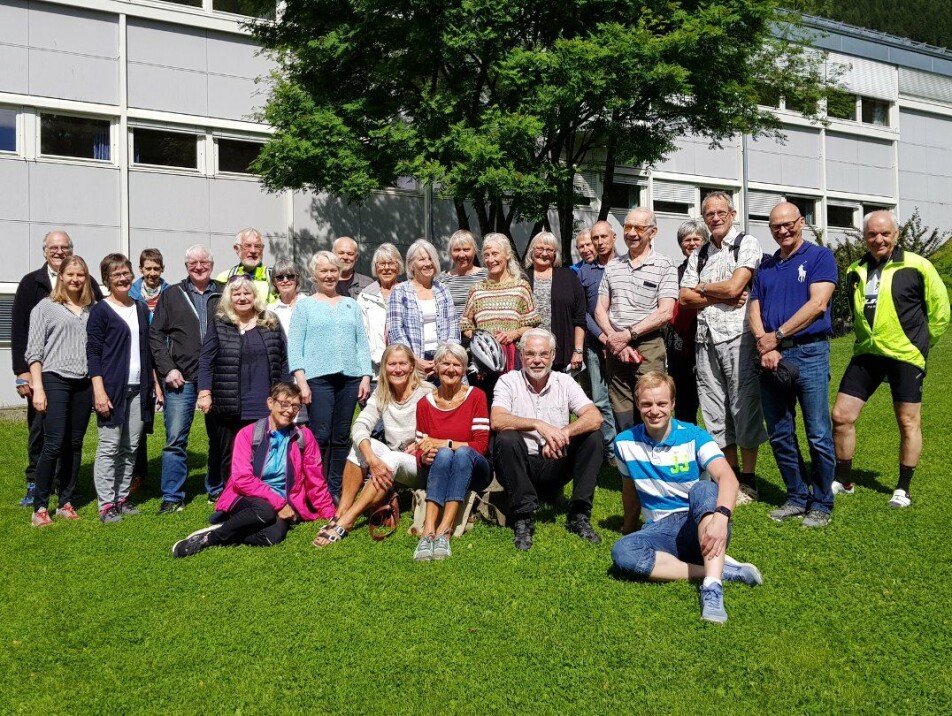THIS ARTICLE/PRESS RELEASE IS PAID FOR AND PRESENTED BY The Norwegian School of Sport Sciences - read more

The elderly and people with pulmonary disease should work out with heavy weights, but without getting breathless
Working out with heavy weights will be beneficial for many older persons, particularly those with pulmonary disease, by increasing strength, stability, improving health and making everyday life much easier.
Up to ca. 1950: Persons with chronic obstructive pulmonary disease (COPD) were recommended to avoid activities that triggered heavy breathing, to rest and to breathe in fresh air. But this did not remedy their breathing problems.
Several years later on: The recommended treatment was amended to cardio work-outs, without this being particularly beneficial. The work-outs were too demanding on breathing capacity to provide any significant improvements physically.
The next recommendation was working out with weights, something most people could at least manage. Knut Sindre Mølmen now believes he has found what could potentially be an even more viable solution:

Many people suffer from COPD without being aware of it
“Weight training is incredibly important for older people, not least for those with chronic pulmonary disorders, but it has to be done correctly. This means: Use heavy weights and carry out the exercises preferably using one leg at a time, if the person has severely impaired pulmonary function. Expert guidance from the very outset is also important.”
COPD is an ever-increasing public health problem, both in Norway and abroad. The disease is one of the most common causes of hospitalisation and death. Elderly persons who smoke or who have smoked on a regular basis are the most commonly affected. The disease has severe ramifications, from a high level of sick leave from work and early retirement to significantly impaired mobility and premature death. Many people suffer from COPD without being aware of it.
It is of decisive importance for a person’s health and quality of life to slow down the development of COPD and, not least, to retain muscle strength. By improving or retaining muscle strength, you can maintain your mobility and balance, manage daily tasks better, minimise the risk of falling and bone fractures, and increase your chances of a longer life.
However, it can be difficult to exercise when you have COPD, even though it is important, so how can this be remedied?

No increased strength from vitamin D
In 2016, Knut Sindre Mølmen initiated a study to explore the benefits of weight training among the elderly, and to find out whether taking high doses of vitamin D at the same time would have an impact on exercise capacity. Research conducted on mice and rats has given reason to believe that extra vitamin D can help increase muscle mass and muscle strength – but there have been no further detailed studies, to date, of this effect in humans.
However, put briefly: Vitamin D produced zero effect. Knut Sindre Mølmen can tell us that neither the healthy participants nor those suffering from COPD gained increased strength from vitamin D.
Most benefits for persons with COPD
“For the persons with COPD, weight training proved particularly beneficial. When compared with the healthy participants, the persons with COPD were weaker before the study started, but improved just as much or more than the healthy persons in all the tests we conducted,” he summarises.
He recruited around 90 elderly persons to take part in a 30-week-long study, and the participants had weight training sessions for 13 of the 30 weeks. Around one third of the participants suffered from COPD, while the others did not. None of the participants had trained with weights systematically prior to the study. The weight training was carried out with light weights for one leg and heavy weights for the other, allowing comparison of results. The participants were tested regularly.
Moving away from old beliefs
“So, the weight training, for the participants with COPD, provided significant improvements in both health, muscle function and muscle biology – more so than with those with healthy lungs and according to several different tests.
The participants were tested for improvements in muscle strength or, in other words, how much they could lift in number of kilograms after the training period, and assigned a rate of progress in percentage points. The increase in the number of kilograms lifted was the same for both the healthy participants and those with COPD, but the persons with COPD actually showed the highest rate of progress in percentage points, most likely due in part to the fact that they had a poorer starting point.
“This refutes the old belief that persons with COPD will benefit less from weight training than healthy persons. This belief is based on the fact that COPD sufferers have a higher level of inflammation and lower oxygen levels in the body than healthy persons, reducing the effect of exercise.”
One leg at a time
'Single-leg exercises' – this was most likely an important factor in the success of Knut Sindre Mølmen’s work-out programme. In earlier studies, participants carried out normal weight training exercises, using both legs or both arms at the same time.
“We decided to do the exercises using one leg at a time. This requires less energy from the body: It allows for more optimal training of muscles without being limited by impaired lung function,” explains Knut Sindre Mølmen. “The result is that they could exercise without being held back by their breathing. The participants performed as many repetitions as they could of each exercise, reaching their limit due to their muscles, not their lungs.”
Easiest to work out with heavier weights
It is now a well-known fact that you have to use heavy weights to gain a positive effect from weight training, so the exercises are strenuous, and you lift the weights for as many repetitions as you can in each series. This is the most beneficial in terms of both muscle strength and muscle mass. The recommended number of repetitions for each series is normally four to twelve.
However, the effect of working out in this way has mainly only been studied on young, healthy persons. There are very few studies of whether elderly people should exercise in the same way, or whether they can also benefit from lifting lighter weights.
The participants on Knut Sindre Mølmen’s study exercised with both light and heavier weights: They performed single-leg exercises with weights that they were able to lift maximum 10 times for one leg and weights they could lift maximum 30 times with the other leg. Both variants proved effective. Nonetheless, Knut Sindre Mølmen believes that it is important to exercise with heavy weights:
“It may seem like a contradiction, but it is easier to perform heavier exercises. Imagine lifting a weight that is so light you can lift it 30 times, and it starts to hurt at around the 18th to 20th repetition. It will not be easy to complete all 30 repetitions!
It also emerged that heavy weights were more effective than light weights in maintaining bone strength.
Use a PT
Knut Sindre Mølmen highly recommends proper guidance in order to get optimal effect from exercise and to prevent injuries.
“If you’re not already familiar with the exercises, you should make use of an expert instructor, a personal trainer or health and training therapist, who can help you get started. If done correctly, weight training can help you live longer!”
He also believes that you have to watch what you eat to obtain the best effect from weight training. “You need to consume enough energy to prevent weight loss, and it’s better to have a few extra kilos. And a significant proportion of energy intake should consist of proteins.”
“Does this mean that both exercise and rehabilitation for the elderly should change, with more focus on weight training?”
“Yes, even though there are a lot of good developments on this front, this is probably even more important than most people realise. We now also know why weight training is so beneficial.”
Of value for a wide range of persons
“The findings from the study are not just of value and effective for rehabilitation of persons with impaired pulmonary function, but are most likely also of relevance for persons with impaired cardiac function, people who suffer from heart failure,” states Knut Sindre Mølmen.
Even though the work-outs themselves will not improve pulmonary function to any significant degree, the study does show that weight training is effective via other mechanisms in improving functional ability for COPD sufferers. Improved muscle strength and more energy-efficient muscles make it easier for persons with COPD to perform everyday activities.
“Old-fashioned” forms of exercise, such as walking, exercising in swimming pools or cycle ergometers are so demanding on the lungs that they are, in practice, extremely difficult to carry out to the level of intensity required to achieve any gains. Moreover, intensive cardio workouts are very uncomfortable for persons with COPD.
Reference:
Knut Sindre Mølmen: The impact of vitamin D3 supplementation, chronic obstructive pulmonary disease and exercise load on resistance training-associated adaptations in older adults. Doctoral dissertation at the Norwegian School of Sport Science, 2021.
See more content from The Norwegian School of Sport Sciences:
-
Football expert wants to change how people watch football at home
-
Kristine suffered permanent brain damage at 22: "Life can still be good even if you don’t fully recover"
-
Para sports: "The sports community was my absolute saving grace"
-
Cancer survivor Monica trained for five months: The results are remarkable
-
What you should know about the syndrome affecting many young athletes
-
New findings on how athletes make the best decisions





































